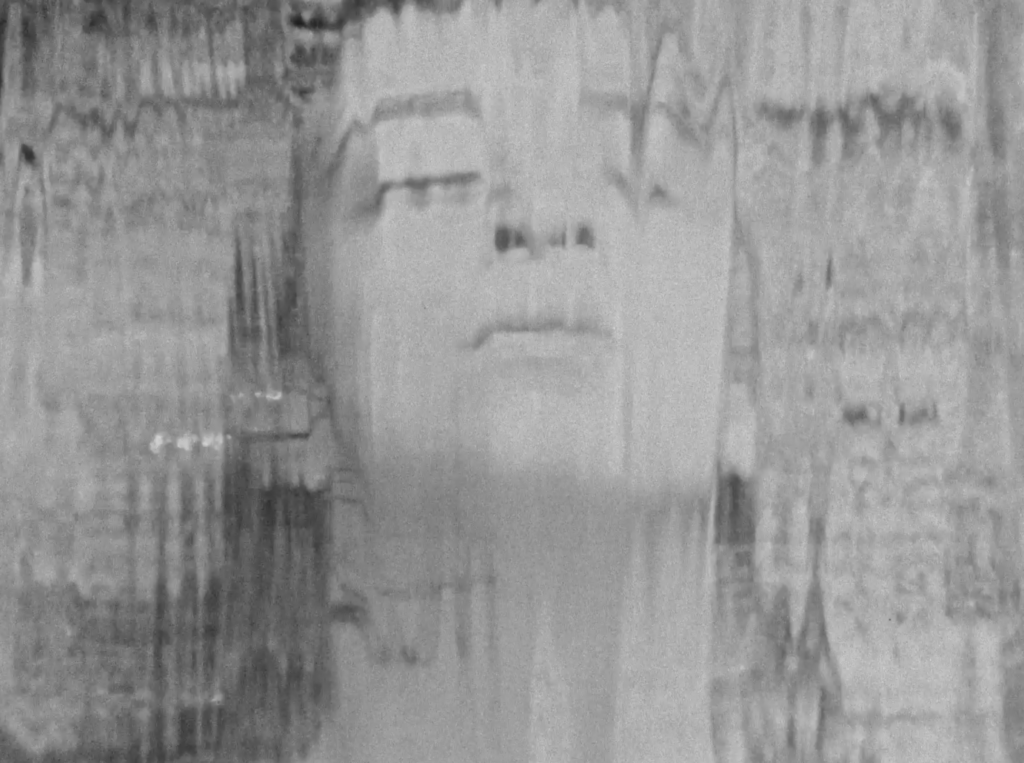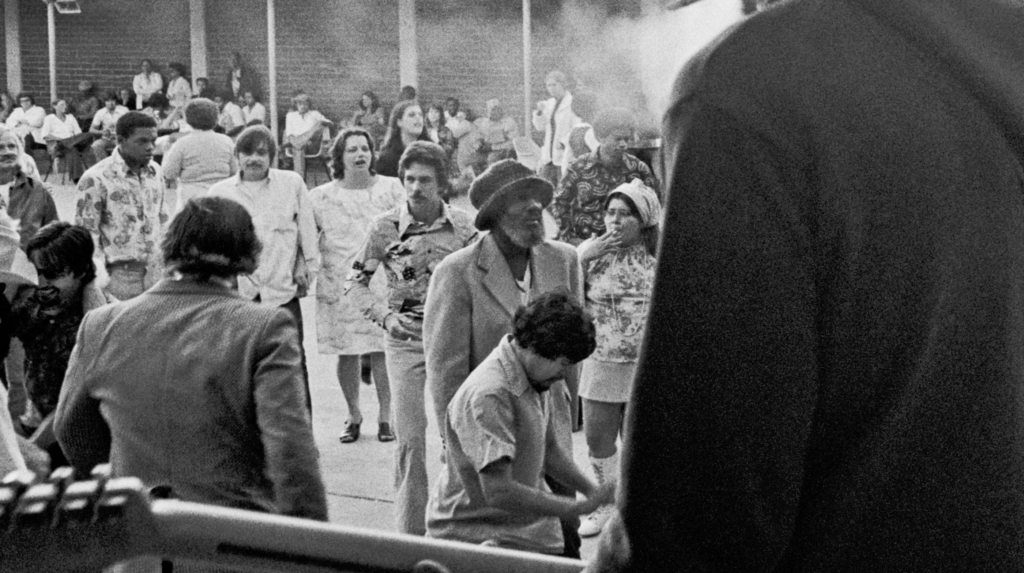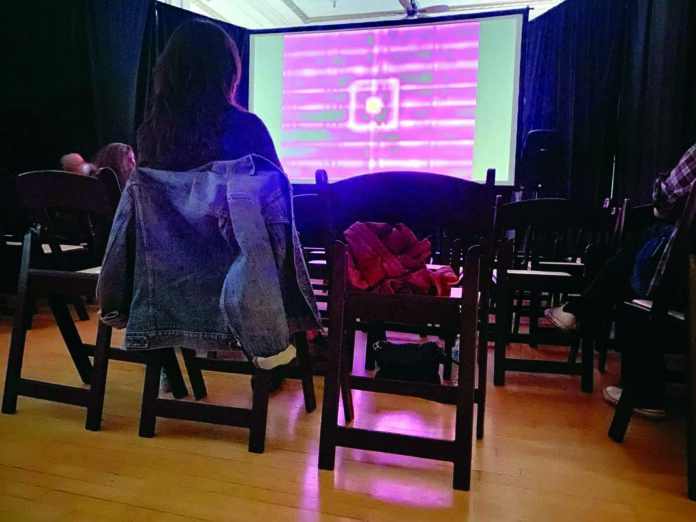On a mid-November weekend, tucked inside the Grand Ballroom of the historic Hotel Petaluma, a few dozen people gathered at an intimate pop-up cinema to watch a selection of “unique, antique and experimental films.”
This was the eighth annual report—as the event is called—of the Camera Obscura Film Society, programmed by co-directors Jonathan Marlow and Amanda Salazar. It marked a return to Petaluma after a few years online and in San Francisco.
Just outside the ballroom, it seemed that most people at the hotel didn’t know the event was going on. Aside from a few social media posts and an enigmatic postcard on a table in the hotel lobby, there wasn’t much advertising. Yet, the society has collected a small crowd of dedicated members since it convened in 2015, and the feeling inside was one of warmth and excitement.
Between its near-secrecy and its curation of obscure works, it would be easy for Camera Obscura to come across as pretentious and exclusive. Instead, it feels like a gift. With decades of experience programming for film festivals and arthouse streaming sites, Salazar and Marlow are professional film lovers inviting viewers to watch a selection of treasures they’ve discovered. Their curation feels at once accessible and mysterious. I watched four of this year’s eight programs and came away eager for more. I loved a few of the films I saw, and enjoyed being there even for the films I didn’t love.
Camera Obscura Film Society is older than its current directors. Marlow and Salazar’s project is conceived of as a re-convening of a society by the same name, founded by Bay Area filmmakers Lawrence Jordan and Bruce Conner, which presented eclectic programs between 1957-1962. Jordan, who now lives in Petaluma, gave Marlow and Salazar his blessing, and his films are featured in each new report.
It was easy for Marlow and Salazar to gain the trust and interest of filmmakers and distributors when they endeavored to revive Camera Obscura, given the deep relationships they had built through their careers. Marlow co-founded and, until 2016, worked as chief content officer of the arthouse streaming service Fandor. Salazar worked with Marlow as Fandor’s director of acquisition.
“Back when Fandor was at the peak of its reputation and production, it was a really wonderful place to work,” says Salazar. “Jonathan carefully built relationships of mutual respect with filmmakers in order to bring on their work….So when we told artists we were starting a small pop-up cinema and wanted to do a live screening of their work, a lot of filmmakers told us, ‘Anything you want. You saw something in my work that no one else saw.’”
By design, Marlow and Salazar don’t reveal much about their lineup in advance. Curious minds can seek out Camera Obscura’s social media page, which announces the film titles in each program a few days before the event, without synopses.
“We’re encouraging people to just have an experience, asking them to trust us—which is a hard thing to ask,” Salazar says, noting that it’s counter to how most people see movies.
Most attendees buy-in to the mystery, as evidenced by a Kickstarter campaign that easily met its goal before the programs were announced. The $7000 budget enables them to rent the venue, purchase equipment to show the works, pay screening fees to artists and provide travel accommodations to visiting filmmakers.
“The fact that a number of people who were there with us have already signed up to participate in the next one is what obliges us to keep doing this,” says Marlow.
Both Salazar and Marlow describe a frequent phenomenon of people showing up for one screening because they know a director, then staying for other programs and returning the following year.
“The idea is not that you’re buying admission to a show. The idea is that all participants are members, even if it’s just for two hours,” Marlow says.
Jointly programmed by Marlow and Salazar, each of the eight programs in this year’s lineup pair shorter works with longer works.
“We give the shorts equal platform with features so that it’s evident that they’re on the same playing field [as features], and the works can be in conversation with each other,” says Salazar.
“A key component of Camera Obscura is to play things that are older with things that are newer to see how they resonate with each other,” adds Marlow.


One program paired Anna Kipervaser’s 2021 short, In Ocula Oculorum, with Chick Strand’s 1979 feature documentary, Soft Fiction. In her introduction to the program, Salazar said that Soft Fiction, which was recently restored, had been on her mind after Roe v. Wade was overturned. She talked about the way bodies are featured in each film, encouraging the audience to talk afterwards about the relationship found between the films.
The experimental short is visceral, presenting flickering images of human bodies—organ systems and brain scans—set to a dissonant, grating soundtrack. In Kipervaser’s words, “In Ocula Oculorum interrogates the unknown and the internal, in both subject matter and experience” and deals with “the contemporary state of perpetual doom.”
In contrast to this harsh viewing, Strand’s black and white film is softer visually, with all of its harshness coming from the content of the stories narrated within it. Filmed between 1976-79 around Los Angeles, five women share candidly about erotic fantasy, sexuality and trauma in oral histories Strand described as “exorcisms of an experience.”
“It’s crucial for us to seek out underrepresented voices,” Marlow says. “It’s always been key to have a large number of women filmmakers and queer filmmakers in the program. We want audiences to see that work because they’re not getting opportunities to see it often enough.”
After this year’s screening of short film, The Shadow Line, by Healdsburg-based filmmaker Toney Merritt, an audience member remarked that they weren’t aware that there are Black filmmakers making experimental work in the Bay Area. The comment opened up a conversation about other local Black experimental filmmakers, but also about how infrequently their films are screened.


The North Bay itself featured prominently in two films screened this year: in Lawrence Jordan’s rarely-seen 1976 film, The Apparition, filmed on a homestead in Laytonville, and in Mike Plante’s 2021 short film, We Were There To Be There, about an unlikely free punk concert The Cramps and The Mutants played for patients at Napa State Mental Hospital in 1978.
When Plante stood up to speak about his film, I was pleased to recognize that he’d been in the audience watching other programs.
“My hope for the future is that one day it will be just an audience of people that come and stay the whole weekend,” says Salazar, whose favorite moments are watching audience members meet one another and then spend the intervals between programs talking about the work, having just experienced the films together.












What a wild and wonderful place!